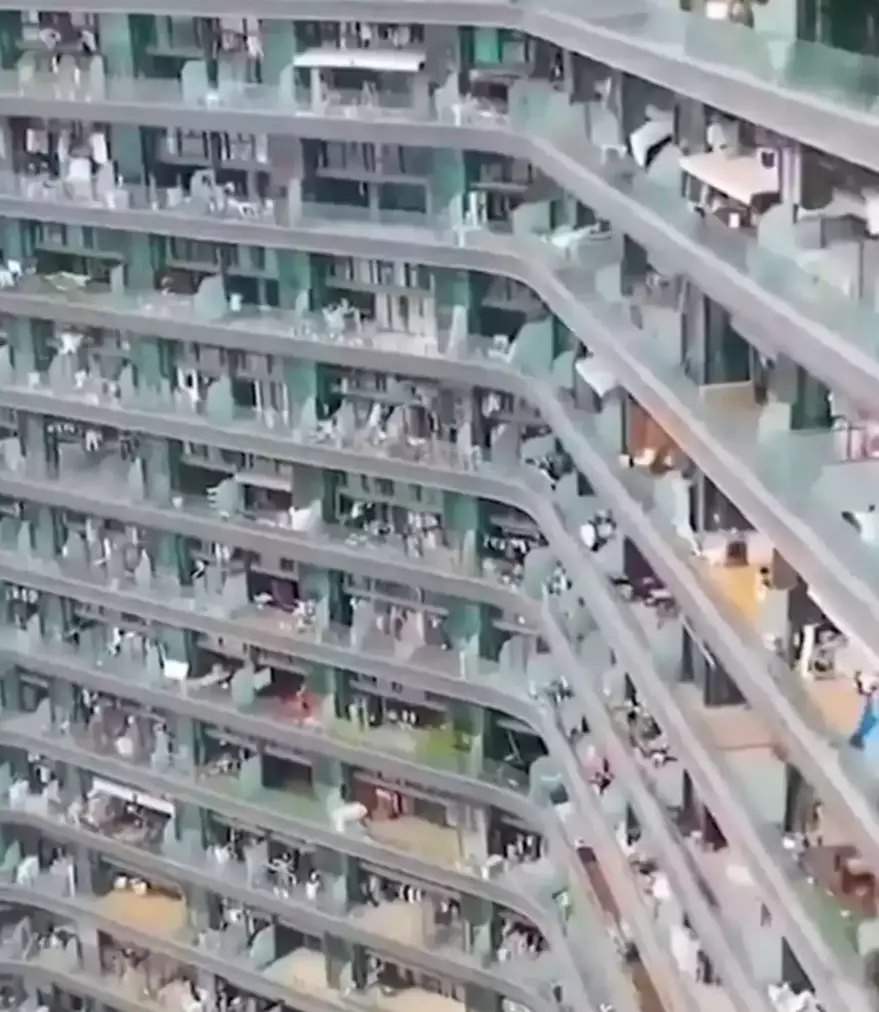A massive residential tower in China, home to 20,000 residents who rarely, if ever, have to step outside, has sparked an eerie mix of fascination and unease across the internet.
Choosing a place to live always comes with trade-offs. Some people value space, while others prioritize natural light or location. But for the thousands of people living inside this colossal high-rise, convenience is the ultimate luxury.
This extraordinary complex is fully self-sufficient, with everything from grocery stores to entertainment venues contained within its towering walls. While some view it as a marvel of modern urban planning, others describe it as something straight out of a dystopian novel.

The Regent International: A City in the Sky
Standing as a colossal landmark in Qianjiang Century City within Hangzhou’s central business district, the Regent International building looms at an astonishing 675 feet tall. Spanning an immense 260,000 square meters, this gigantic high-rise is among the largest residential structures in China. With an original design capacity of 30,000 residents, it currently houses approximately 20,000 individuals—comparable to the population of an entire small town.
Originally conceptualized by Alicia Loo, the mastermind behind Singapore’s renowned Marina Bay Sands Hotel, this architectural giant was initially intended to be a luxurious six-star hotel. However, it was instead developed into an affordable living space tailored to accommodate young professionals. Rental costs for these apartments vary, with smaller units available for around $220 per month, while premium apartments with balconies can cost up to $550.
A Self-Contained World
What sets Regent International apart from traditional apartment buildings is its self-sufficiency. Unlike conventional urban dwellings that rely on external shops and facilities, this enormous structure functions like a self-contained micro-city. Residents never have to venture beyond its towering walls to fulfill their daily needs.
The complex boasts an array of amenities that rival those of an entire district. Inside, residents have access to an extensive food court offering a variety of cuisines, numerous supermarkets stocked with daily essentials, and barbershops and nail salons to cater to grooming needs. Recreational facilities include swimming pools, gyms, and even internet cafes, making it entirely possible for residents to live comfortably without ever needing to step outside.
Public Reactions: A Visionary Concept or a Nightmarish Reality?
The internet is deeply divided over the concept of such a high-density, self-sustained living space. While some admire the efficiency and convenience of the Regent International, others find it deeply unsettling.
Social media users have voiced strong opinions, with one Facebook commenter expressing their dismay: “This looks like an utterly bleak and lifeless future. It feels like total control over people’s lives. We need to preserve natural spaces where people can interact freely.”
Another user on Reddit found the sheer scale of the building overwhelming: “I can’t even imagine what it must feel like to live with that many people under one roof. I’ve lived in entire towns with that kind of population. The idea of all those people confined to one giant building is just mind-boggling.”
Meanwhile, a TikTok viewer shared their visceral reaction: “Just looking at this building makes me feel claustrophobic.”
However, not everyone sees it in a negative light. Some believe that such structures are simply a modern adaptation of urban living. A Facebook user pointed out, “This is actually quite practical. With remote work and online shopping, you don’t really need to leave home that often anyway.”
A Reddit user even joked about the logistics of daily life in such a vast residential tower: “I can’t even begin to imagine the elevator traffic during rush hour. You might need to start your day an hour early just to make it to the ground floor!”
A Trend Spreading Beyond China
While the Regent International has captivated global attention, similar high-density residential complexes are not unique to China. In other parts of the world, particularly in major cities like Hong Kong, such developments are a common urban solution.
One Reddit user shed light on the scale of these mega-structures, saying: “Hong Kong is full of 50-story residential buildings, each with up to 100 apartments per floor. These blocks are often clustered together in groups of 10 to 20, creating neighborhoods that can house anywhere from 15,000 to 50,000 people. That’s why they’re often referred to as ‘vertical villages.’”
Beyond just providing housing, many of these high-rise communities offer a comprehensive range of amenities, from sports complexes and clubhouses to playgrounds, nurseries, and even schools. Some compare them to cruise ships, floating high above bustling city streets, where every need is met within an enclosed environment.

A Glimpse Into the Future?
The rise of self-sustained, high-density apartment complexes like Regent International raises profound questions about the future of urban living. For some, they represent an efficient, space-saving solution to housing crises in densely populated cities. For others, they embody a worrisome shift toward isolated, technology-driven lifestyles where human interaction becomes increasingly rare.
Regardless of one’s perspective, it’s clear that buildings like Regent International are pushing the boundaries of modern architecture and redefining what it means to call a place home.
